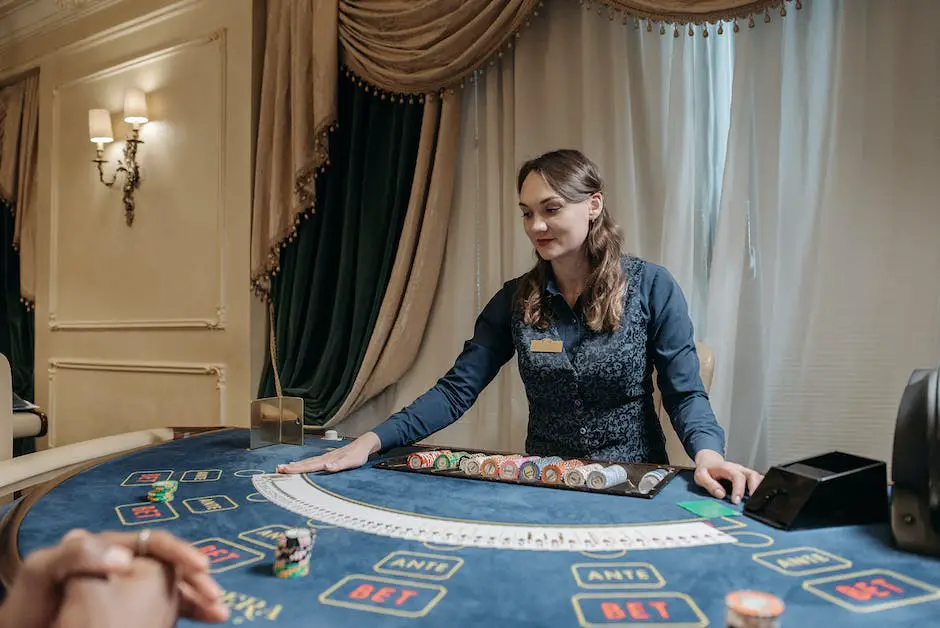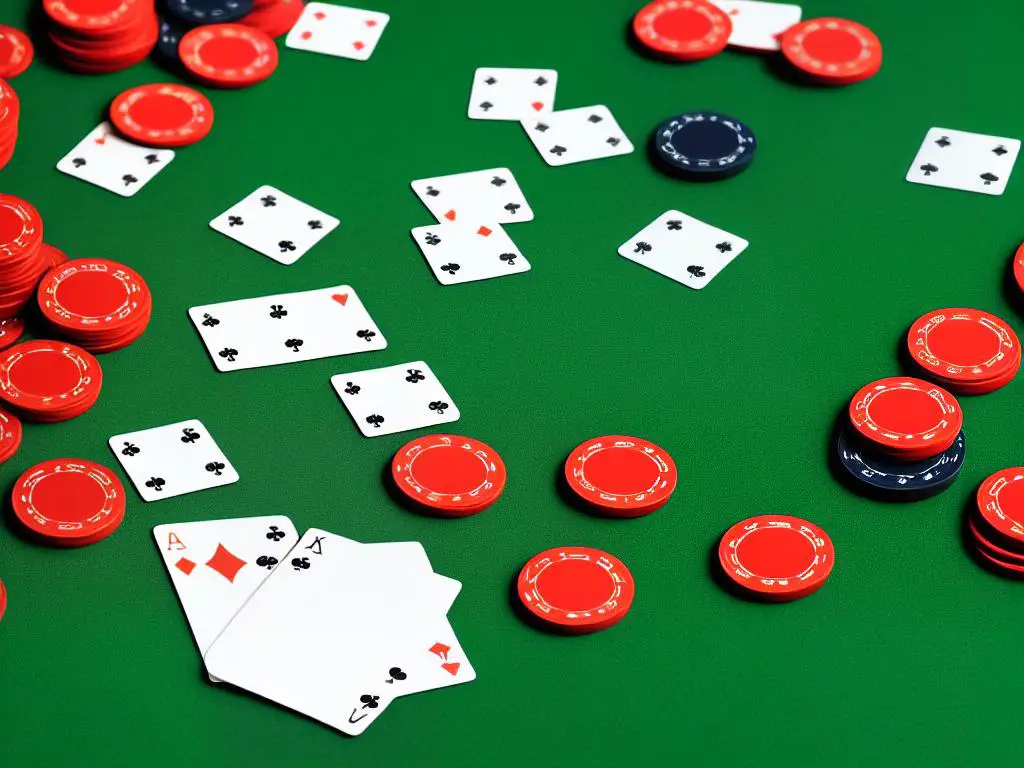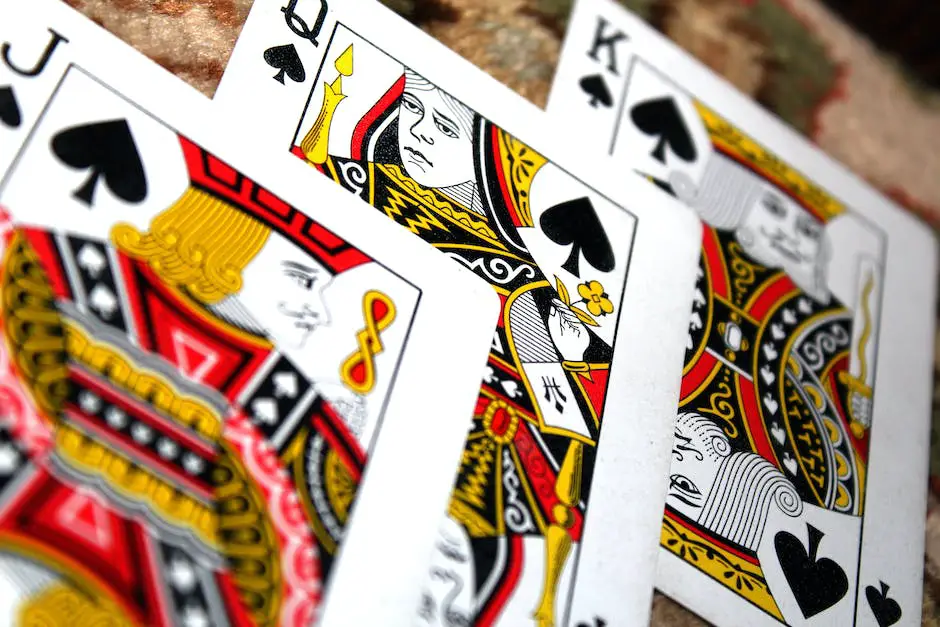Every card game has its allure, but the thrill of blackjack, the quintessential fusion of luck and skill, is unmatched. As you delve into the world of blackjack in this comprehensive blog post, you’ll not only grasp the basics of this dynamic game but also tap into advanced strategies that could potentially elevate your game to the next level. Whether it’s the tried and true card counting approach, the rudimentary strategies tailored to lessen the house edge for beginners, or the more complex strategies for seasoned players – there’s something here for everyone. Not just that, the impact of game variants on your playing style and crucial pointers on bankroll management are all covered to offer you a holistic perspective on this fascinating game of 21.
Understanding the basic rules
Blackjack, one of the most popular casino games in the world, offers the best odds of winning against the house. It’s a game where participants play against the dealer, and the objective is to have a hand value as close to 21 without going over, while still having a higher total than the dealer. Understanding its basic rules, the value of the cards, and knowing the game’s objectives form the cornerstone of developing robust blackjack strategy.
Playing Blackjack
The first point to note about blackjack is that it is typically played with one, two, four, six, or eight decks of cards, which are shuffled together before each hand is dealt. The most basic goal in blackjack is to best the dealer’s hand without exceeding a total of 21. Players exceed this total, they “bust”, and regardless of the dealer’s hand, they lose.
Card Values
- The cards from 2 to 10 are valued as indicated
- Face cards (King, Queen, and Jack) are all worth 10 points
- The Ace can be counted as either 1 or 11 points according to the player’s choice.
In the game, a”blackjack” refers to any hand of an Ace plus a 10 or face card regardless of suits or colors. The term “blackjack” itself wins the game, and the player with such a hand is immediately paid 1.5 times the original wager (unless the dealer also has a blackjack, which leads to a tie).
How to Play
Part of the blackjack’s appeal lies in its simplicity. A dealer gives two cards to each player, including themselves, where one of the dealer’s cards is hidden until the end. All the players then, in turns, decide whether to take additional cards (“hit”) or stay put with their current cards (known as “stand”) to reach a sum as close to 21 as achievable.
Dealer’s Hand
Understanding the dealer’s hand is crucial. In almost all types of blackjack, the dealer is committed to hit until they reach a total of 17 or more. Players, on the other hand, can decide if they want to hit or stand, giving them more control over the outcome of the game.
Strategic Decisions
One of the most strategic decisions a player can make is to “double down”. This move allows a player to double their bet in the middle of a hand in exchange for one extra card. It’s a risk-taking strategy but can lead to a larger payoff. Similarly, if a player receives two cards of the same value, they have the option to “split” the hand into two separate hands, thereby potentially increasing their chances of winning.
Final Words
Wrapping things up, gaining a robust comprehension of blackjack’s fundamental rules is pivotal to gaining an edge in the game. Understanding the exact card values, the strict guidelines steering the dealer’s choices, and the strategic options available to the player can markedly change the trajectory of the game. Equipped with this proficiency, players can experiment with varying strategies and fine-tune their tactics, thereby amplifying their probabilities of not just surpassing the dealer, but also emerging as victors from the blackjack table.

Card counting strategy
Unpacking Card Counting in Blackjack
Card counting in blackjack is a technique employed to ascertain if the subsequent hand is likely to benefit the player or the dealer. It offers an effective system to enhance the player’s odds by diminishing the house edge. In the following discussion, we delve into how this process works, its advantages, and dispelling the myth surrounding its illegality. For a comprehensive guide to card counting, check out this blog here!

Basic Blackjack strategy
Blackjack, a casino game that skillfully combines elements of chance and strategy, offers players not only entertainment but also potential profitability when approached correctly. Though the luck of the draw plays a part, your decision-making prowess largely shapes the outcome of each round of play. The central goal is to assemble a hand that comes nearer to a total of 21 than the dealer’s without surpassing it. The basic strategy, a decision-making guide derived from mathematical calculations, helps optimize your odds based on variables such as hand value and the dealer’s visible card.
Understanding the Basic Concepts
Before delving into the strategic part, it’s important to understand the basic concepts. Your hand value is the combined value of the cards you’ve been dealt. The face cards (king, queen, jack) are worth 10 points each, while the ace card can be worth either 1 or 11 points, depending on your choice. The number cards are worth their face values. The dealer’s face-up card is crucial in shaping your game strategy.
When to Hit
In general, if your hand value is anywhere between 5 and 8, you should always ‘hit’ or take another card, irrespective of the dealer’s upcard. If your hand value is 9, ‘hit’ if the dealer’s upcard is anything between 2 and 6; otherwise, double down. If your hand is valued at 10 or 11, double down if your value is more than the dealer’s upcard value. Or not, ‘hit’.
When to Stand
You should ‘stand’ or not ask for another card if your value is either a hard 17 or above (hard means your hand doesn’t include an ace). If you possess a soft 18 or above (soft means your hand includes an ace), standing becomes the best option, to avoid busting or going over 21.
Double Down Strategies
‘Doubling down’ is an advantageous move where you double your initial bet, but only take one extra card. This move should ideally be performed when the total of your hand cards is 9, 10, or 11 and the dealer’s upcard is a low value.
Splitting Pairs Strategy
Splitting pairs, or dividing your pair into two separate hands, can be done when you’re dealt pairs. You should always split aces and eights regardless of the dealer’s upcard. However, you should never split tens as it’s already a strong hand, and same goes for 5s, since their combined value of 10 is quite advantageous to ‘double down.’
Surrender
Finally, the least common play is the ‘surrender.’ This is where you abandon your hand and retrieve half your bet. It’s not available in all casinos and generally advised to use when your chances of winning are incredibly low. For instance, if you have a total of 15 and the dealer’s upcard is a 10.
Mastering the Game
Acquiring blackjack strategy mastery isn’t an overnight feat; it demands time, patience, and consistent practice. These basic strategies provide a crucial foundation for beginners but bear in mind that they don’t ensure an immediate win. Part of the beauty of casino games like blackjack lies in its unpredictability. Getting a grasp of the basics will undoubtedly start you on the journey to understanding the game and, after continuous practice, you can nevertheless expect a significant improvement in your decision-making skills. But remember, don’t get discouraged if you’re not winning right off the bat, persist at playing, learning, and above all, make sure to enjoy the game!

Advanced Blackjack strategies
Getting a fundamental understanding of blackjack is crucial. The fundamental strategy is rooted in the math-derived probabilities of a given hand versus the dealer’s hand. This strategy should be your initial approach as it’s reasonably easy to comprehend and apply. To develop your basic strategy, you must be aware of the game rules, understand the worth of each card, and be knowledgeable of the dealer’s play. Under the fundamental strategy, the concept is simple: if your card’s value is 9 or less, you should hit; but with a value of 10 or 11, double down if your value surpasses the dealer’s up-card. If your hand’s total value is 17 or more, you should stand. As a general rule, avoid insurance as it offers the house a better edge.
Shuffle Tracking in Blackjack
Shuffle tracking is a popular technique found in more advanced blackjack strategies. It involves monitoring certain areas of the deck through the shuffling process. This strategy aims to predict where the high-value cards are within the deck and subsequently place high bets when these card segments are due for play. Shuffle tracking demands notable card recognition and shuffling abilities. It takes time and perseverance to master since a keen eye, accurate estimation skills, and the ability to quickly adapt your bet size as the game swings in your favor are needed.
Hole Carding Technique
Another useful blackjack strategy is hole carding. In hole carding, the player tries to take a peek at the dealer’s hole card. You need to be quick and alert for this strategy. Ideally, take the anchor’s position – that’s the last position to the right of the dealer for the best vantage point. If the dealer is careless and exposes the hole card, this can provide pivotal information about his hand. Remember that effectively using the hole carding strategy depends largely on the dealer’s style; hence observing the dealer’s habits beforehand is essential.
Team Play Strategy
Team play strategy is another sophisticated blackjack method often portrayed in movies like ’21’. As the name suggests, this strategy involves a group of players jointing effort to outsmart the house. A team play approach can confuse the house, evade detection and maximize winnings. Typically, a team is organized into ‘spotters’ who keep track of the deck’s count while betting the minimum at several tables, and a ‘big player’ who places massive bets when the count turns favorable. Trust among team members, excellent coordination, and quick-thinking are pivotal for a successful team play strategy.
Elite Counting Systems
Developing an adept counting system represents another advanced and potentially lucrative strategy. The aim is to memorize which cards have been dealt in order to inform your next move based on statistics. In Blackjack, previous rounds do have a subtle influence on what could happen in the upcoming rounds. Knowing this, if you are aware of cards that have been played, you can adjust your play accordingly. This concept is what’s known as card counting, where the count begins at zero and either increases or decreases with each dealt card. Such practice can tremendously impact your best play decision and optimal betting level.
To conclude, a good understanding and adept implementation of these intricate blackjack strategies can significantly swing the odds in your favor. Just as with any skill-based pursuit, practice is crucial. You should begin with mastering the basic strategy, then gradually learn and incorporate more advanced techniques. Above all, don’t forget to be patient, observant, and make smart decisions. Blackjack isn’t all about luck, indeed, it’s also a game that invites skill, strategy, and calculated risks.

Choosing the right game variant
Diving Deeper into the Universe of Blackjack
The universe of blackjack is diverse and dynamic, brimming with a host of game variants each sporting its own rules, house edges, and unique impacts on strategy. Familiarizing yourself with these variations can enrich your blackjack strategy as you can then pick games that align best with your personal skills and playing style. This guide will illuminate a gamut of these blackjack variations, highlighting their unique features and explaining how they can impact your gameplay strategy.
Classic Blackjack
Classic Blackjack, often just referred to as Blackjack, is the most popular version of the game. In this format, the house edge (the advantage the casino has over the player) is usually around 0.5% when players utilize basic blackjack strategy. This small house edge is one of the reasons why Classic Blackjack is so popular. The game is typically played with 4-8 decks and both the player and dealer are dealt two cards initially, with the aim of the game being to get a hand value as close to 21 as possible without going ‘bust’.
European Blackjack
Another prominent variant is European Blackjack. Two decks are typically used in European Blackjack, which can reduce the house edge slightly. However, the dealer typically does not reveal their hole card (the face-down card) until after the players have made all of their decisions, which can affect the player’s strategy as they are in the dark about the dealer’s hand for longer.
Blackjack Switch
Blackjack Switch offers a unique twist on the traditional game which can significantly alter gameplay. In this variant, players are dealt two hands instead of one and have the option to ‘switch’ the second cards dealt to each hand. While this gives players increased flexibility, the game compensates for this advantage by implementing rules like a dealer 22 resulting in a push (a tie) rather than a player win. This increases the house edge compared to Classic Blackjack.
Double Exposure Blackjack
In Double Exposure Blackjack, both of the dealer’s cards are dealt face up, providing players with more information from the get-go. This might seem like an advantage for players, but to counterbalance this, the game imposes restrictions like dealer wins on ties and reduced payouts for blackjacks (paying even money instead of 3 to 2). This also makes the house edge higher than in Classic Blackjack.
Spanish 21
Spanish 21, a variant that is played without 10-value cards, offers numerous bonuses for specific hands and provides players with more options such as late surrender and re-splitting aces. These rule changes can offer players an exciting change of pace but generally increase the house edge slightly compared to Classic Blackjack.
Selecting the Right Variant
When it comes to choosing a blackjack variant, the subtle differences in rules and the impact on the house edge are worth considering. Your strategy will need to be fine-tuned based on the specific rules of the game you opt for. Whether it’s traditional blackjack or a variant with a creative spin, enhancing your knowledge of the game’s intricacies can sharpen your acumen, giving you a leg up and heightening your prospects of winning.

Bankroll management and gambling responsibly
Mastering the Art of Bankroll Management and Responsible Gambling
Equally essential components of an effective blackjack strategy are the efficient management of your bankroll and responsible gambling. In this light, blackjack isn’t just about crunching numbers and calculating odds, but also about maintaining self-control and understanding the psychology of the game.
Understanding Bankroll Management
Bankroll management is effectively figuring out how much money you are willing to risk or lose in a gaming session. This should be a predefined amount that you are comfortable losing, because even with the best strategies, there is always a potential to lose in games of chance. It’s important to establish betting limits to avoid depleting your bankroll too quickly.
A common strategy is the ‘5% rule’, whereby you never wager more than 5% of your bankroll on a single bet. This manages your risk and ensures you have enough funds to play over a longer session. The key to successful bankroll management is to make bets in proportion to your existing bankroll. If you’re on a winning streak, your bets increase proportionally, and if you’re losing, your bets decrease accordingly.
Knowing When to Increase or Decrease Your Bets
Understanding when to increase or decrease your bets is another vital part of blackjack strategy linked to bankroll management. If you’re on a winning streak, it can be tempting to increase your bets significantly. While this can lead to bigger wins, it can also deplete your bankroll faster if your luck changes.
One common strategy is the ‘martingale system’, where after every loss, you double your bet to recoup previous losses and profit from the original bet. However, this strategy can be risky as losing streaks could rapidly deplete your bankroll. A less risky alternative is the ‘paroli system’ which advocates doubling your bet after every win instead. The idea is to exploit winning streaks and minimize losses during losing streaks. Both these systems, however, should be used with caution and within the predefined bankroll limits.
Importance of Gambling Responsibly
Playing blackjack is exciting and fun, but it’s important to remember that it should remain a form of entertainment. Reigning yourself in when you’re on a roll or chasing losses can be a challenge but it’s essential for gambling responsibly.
Setting a limit is an effective way to curb excessive gambling. This could be a daily, weekly, or monthly limit and once you reach it, you stop playing.
Understand that the gambling establishment always has an edge. Over the long run, the house will always make a profit. Remembering this can help you play within your limits and keep the game fun and enjoyable.
Overall
Good blackjack strategies incorporate both technical game strategies and broader psychological elements like bankroll management and responsible gambling. By keeping a handle on both these elements, you can make the most of your blackjack games, make the fun last longer and potentially walk away a winner. With disciplined bankroll control, knowledge of when to adjust your bets and a responsible gambling perspective, blackjack becomes both more enjoyable and rewarding.

Blackjack is an enthralling and challenging game that offers tremendous rewards to those who can master its strategies. However, while this game is about skill, strategy, and sometimes, pure luck, it’s also about discipline. Knowing the right game variant to play, managing your bankroll wisely, and understanding when to stake higher or lower are as critical as knowing when to hit or stand. As our journey through blackjack’s varied landscapes culminates, always remember: while the aim is to beat the dealer and amass winnings, the game’s real enjoyment lies in the process – the decisions made, the risks taken, and the lessons learned. Blackjack isn’t just a game; it’s a continuous learning experience that teaches critical life skills like patience, calculated risk-taking, and resilience.
FAQ – Mastering Blackjack: Uncover Winning Strategies
Q: How can I improve my Blackjack skills?
A: Our blog provides winning strategies, tips on card playing decisions, understanding odds, and maximizing your chances of success in Blackjack.
Q: What is the basic strategy in Blackjack?
A: Basic strategy involves making optimal playing decisions based on your hand and the dealer’s upcard. It minimizes the house edge and maximizes your winning potential.
Q: Can I count cards in Blackjack to gain an advantage?
A: Card counting is a strategy that can provide an advantage in Blackjack by tracking the ratio of high and low cards. Our blog discusses card counting techniques.
Q: Are there different variations of Blackjack?
A: Yes, there are various Blackjack variations with slight rule differences. Our blog covers some popular variations and provides strategies specific to each variant.
Q: Can I practice Blackjack without risking real money?
A: Absolutely! Our blog suggests online platforms and mobile apps where you can play Blackjack for free to practice your skills and test different strategies.
Q: How can I manage my bankroll effectively in Blackjack?
A: Bankroll management is crucial in Blackjack. Our blog offers insights into setting betting limits, managing wins and losses, and maintaining discipline.
Q: Are there other betting strategies I can use in Blackjack?
A: Yes, beyond basic strategy, there are different betting systems such as progressive or flat betting. Our blog discusses these strategies and their pros and cons.
Q: Can I play Blackjack online?
A: Yes, there are online casinos and gambling platforms that offer Blackjack games. Our blog provides recommendations for reputable online Blackjack sites.